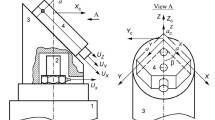Abstract
Investigation of this paper is a preliminary to the calibration of vibration rectification error (VRE) with multiple inputs. Considering the accelerometers stimulated by vibration and intended input, present testing methods for VRE cannot evaluate the exact influence of vibration. For measuring VRE caused by concurrent constant and vibratory accelerations, a multi-component mechanical system called vibrafuge was introduced. At first, combined accelerations produced by the vibrafuge was deduced by homogeneous coordinate transformation. Validation of testing VRE with vibrafuge is done by the equation of the combined accelerations. Then a general expression of the VRE caused by the combined accelerations was derived from a model of the accelerometer under test. Based on the VRE model, linear relation between the constant acceleration and VRE was testified by theoretical and numerical analysis.





Similar content being viewed by others
References
IEEE Standard 528-2001, IEEE Standard for inertial sensor terminology, (2001).
IEEE Standard 1293TM-1998(R2008), IEEE Standard specification format guide and test procedure for linear, single-axis, nongyroscopic accelerometers, (2008).
P.H. LaFond, Low vibration rectification in a closed-loop, in-plane MEMS device, Patent No.: US 7,949,508 B2, Honeywell International Inc., (2011).
D.F. Rojo, E.C. Abbott and M.J. Robinson, Methods and apparatus for reducing vibration rectification errors in closed-loop accelerometers Patent No.: US 7,131,315 B2, Honeywell International Inc., (2006).
IEEE Standard 836-2009, IEEE recommended practice for precision centrifuge testing of linear accelerometers, (2009).
ISO 5347-8:1993(E), Methods for the calibration of vibration and shock pick-ups-part 8: primary calibration by dual centrifuge first edition, (1993).
ISO 16063-31, Methods for the calibration of vibration and shock transducers-Part 31: testing of transverse vibration sensitivity, (2009).
C.S. Veldman, Implementation of an accelerometer transverse sensitivity measurement system, Proceedings of test and measurement conference, (2012).
R. Jepsen and E. Romero, Testing in a combined vibration and acceleration environment, Proceedings of IMAC XXIII, Orlando, (2005).
Actidyn Systems., V67 Technical Description, Available online: http://www.actidyn.com/wp-content/uploads/2010/06/v67.pdf, (2010).
T. Liao, Modeling and analysis of laser shaft alignment using 4 × 4 homogeneous coordinate transformation matrix, Measurement, 42(1) (2009) 157–163.
X.J. Chen and S.Q. Ren, Two algorithms of working acceleration generated by a precision centrifuge with two rotating axes, J. Harbin Inst. Technol., 13 (2006) 1–3.
M. Szczotka and S. Wojciech, Application of joint coordinate and homogeneous transformation to modeling of vehicle dynamics, Nonlinear Dynam., 52(4) (2008) 377–393.
C. Zaiss, IMU design for high vibration environments with special consideration for vibration rectification, University of Calgary, 2012, 29–30. Available online: http://hdl.handle.net/11023/161.
Acknowledgments
The authors gratefully acknowledge the support from the National Natural Science Foundation Innovation Group of China under Grant 61121003, the Program for Changjiang Scholars and Innovative Research Team in University (PCSIRT), and the National Defense Technology Basic Scientific Research Program of China (Type A) under Grant J052012B001.
Author information
Authors and Affiliations
Corresponding author
Rights and permissions
About this article
Cite this article
Guan, W., Meng, X.F. & Dong, X.M. Testing Vibration Rectification Error with Vibrafuge. MAPAN 29, 289–294 (2014). https://doi.org/10.1007/s12647-014-0101-5
Received:
Accepted:
Published:
Issue Date:
DOI: https://doi.org/10.1007/s12647-014-0101-5




